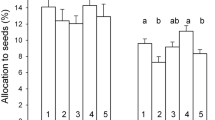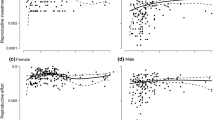Summary
The energy allocation patterns to reproductive structures (RA) and the propagule output (PN) of five annual weedy or ruderal fox-tail species (Gramineae)-Setaria viridis (2x) (including var. pachystachys (2x)), S. X pycnocoma (2x), S. faberi (4x), S. glauca (4x, 8x), and S. pallide-fusca (8x)-were studied in relation to their biomass on the materials from ten different wild populations in Toyama and Fukui Prefectures, Japan. In addition, the relationship between the RA and PN was also critically examined.
For all five fox-tail species, proportional partitioning of dry matter into total reproductive structures (caryopses, bristles, inflorescence axis and other persistent floral organs at the fruiting stage) (RA) shows considerable overlaps, but more or less constant within each taxon and independent of the biomass. On the other hand, the number of propagules produced per plant (PN) is remarkably dependent on the size of plants and thus a function of the biomass. This high efficiency of energy allocation to propagules is evidently determined by the breeding system (i.e., predominant inbreeding) of these weedy annual species. However, the relationship between the RA and PN showed no conspicuous trend, and thus the reproductive output is also independent of RA. The reproductive strategy found in Setaria is perhaps typical in such weedy annuals which grow chiefly in frequently disturbed, unpredictable environments. Another notable discovery was that, in spite of differences in ploidy levels (from 2x to 8x), all five species showed a very similar reproductive strategy, although slight but clear decrease was noted in the RA in response to the increase in ploidy levels, ranging from 49.52% (in diploids) to 27.53% (in tetraploids and octoploids). Seed weight (per gram), on the contrary, clearly increases in response to the increase in ploidy levels, i.e., ranging from 7.09×10-4 g (in diploids) to 41.87×10-4g (in octoploids).
Similar content being viewed by others
References
Abrahamson WG, Gadgil M (1973) Growth form and reproductive effort in goldenrods (Solidago, Compositae). Amer Nat 107:651–661
Baker HG, Stebbins GL (eds) (1965) The Genetics of Colonizing Species. Academic Press, New York, pp 1–588
Bierzychudek P (1981) Pollinator limitation of plant reproductive effort. Amer Nat 117:838–840
Bierzychudek P (1982) The demography of Jack-in-the-pulpit, a forest perennial that changes sex. Ecology (in press)
Bradshaw AD (1965) Evolutionary significance of phenotypic plasticity in plants. Adv Genet 13:115–155
Clements FE, Weaver JE, Hanson HC (1929) Competition in cultivated fields. Carnegie Inst Wash Publ 398:202–233
Donald CM, Hamblin J (1976) The biological yield and harvest index of cereals as agronomic and plant breeding criteria. Adv Agron 28:361–405
Evenson WE (1981) Experimental studies of reproductive energy allocation in plants. In: CE Jones, RJ Little (eds) Handbook of Experimental Pollination Biology. Van Nostrand Reinhold Co., New York, p 1–63
Gross KL (1981) Predictions of fate from rosette size in four “biennial” plant species: Verbascum thapsus, Oenothera biennis, Daucus carota, and Tragopogon dubius. Oecologia (Berlin) 48:209–213
Harper JL (1961) Approaches to the study of plant competition. Symp Soc Exper Biol 15:1–39
Harper JL (1967) A Darwinian approach to plant ecology. J Ecol 55:247–270
Harper JL (1977) Population Biology of Plants. Academic Press, New York, p 1–892
Harper JL, Ogden J (1970) The reproductive strategy of higher plants I The concept of strategy with special reference to Senecio vulgaris L. J Ecol 58:691–698
Hickman JC (1975) Environmental unpredictability and plastic energy allocation strategies in the annual Polygonum cascadense (Polygonaceae). J Ecol 63:689–701
Hitchcock AS (1950) Manual of the Grasses of the United States. US Dept Agr Misc Publ No. 200, p 1–1051
Hubbard CE (1954) Grasses. A Guide to Their Structure, Identification, Uses, and Distribution in the British Isles. Hardmondsworth, Middlesex, Peguin Book Ltd., London
Kawano S (1975) The productive and reproductive biology of flowering plants II The concept of life history strategy in plants. J Coll Lib Arts, Toyama Univ Japan 8:51–86
Kawano S (1981) Trade-off relationships between some reproductive characteristics in plants with special reference to life history strategy. Bot Mag Tokyo 94:285–294
Kawano S, Hayashi S (1977) Plasticity in growth and reproductive energy allocation of Coix Ma-yuen Roman. cultivated at varying densities and nitrogen levels. J Coll Lib Arts, Toyama Univ Japan 10:61–92
Kawano S, Hiratsuka A, Hayashi K (1982) The productive and reproductive biology of flowering plants V Life history characteristics and survivorship of Erythronium japonicum. Oikos 38:129–149
Kawano S, Masuda J (1980) The productive and reproductive biology of flowering plants VII Resource allocation and reproductive capacity in wild populations of Heloniopsis orientalis (Thunb.) C Tanaka (Liliaceae). Oecologia (Berl) 45:307–317
Kawano S, Nagai Y (1975) The productive and reproductive biology of flowering plants I Life history strategies of three Allium species in Japan. Bot Mag Tokyo 88:281–318
Kawano S, Nagai Y (1982) Further observations on the reproductive biology of Erythronium japonicum (L.) Decne. (Liliaceae). J Phytogeogr & Taxon (Kanazawa) 30 (in press)
Kishimoto E (1938) Chromosomenzahlen in den Gattungen Panicum and Setaria I Chromosomenzahlen einiger Setaria-Arten. Cytologia 9:23–27
Moffet AA, Hurcombe R (1949) Chromosome numbers of South African grasses. Heredity 3:369–373
Ohara M, Kawano S, Ito K Life history evolution in the genus Trillium (Liliaceae) I Reproductive biology and survivorship of four Japanese species. (MS in preparation)
Ohwi J (1965) Flora of Japan. Smithsonian Institution, Washington, DC p 1–1067
Palmblad IG (1968) Competition in experimental populations of weeds with emphasis on the regulation of population size. Ecology 49:26–34
Salisbury EJ (1942) The Reproductive Capacity of Plants. Bell & Sons, London
Salisbury EJ (1975) The survival value of modes of dispersal. Proc Royal Soc London B 188:183–188
Salisbury EJ (1976) Seed output and efficacy of dispersal by wind. Proc Royal Soc London B 192:232–329
Schemske DE (1980) Evolution of floral display in the orchid Brassavola nodosa. Evolution 34:489–493
Schemske DE, Wilson MF, Melanpy MN, Miller LJ, Verner L, Schemske KM, Best LB (1978) Flowering ecology of some spring woodland herbs. Ecology 59:351–366
Singh DN, Codward MBE (1960) Cytological studies in the Gramineae. Heredity 15:193–199
Soule JD, Werner PA (1981) Patterns of resource allocation in plants, with special reference to Potentilla recta L. Bull Torrey Bot Club 108:311–319
Tarnavschi IT (1948) Die Chromosomenzahlen der Anthophyten-Flora von Rumänien mit einem Ausblick auf das Polyploidie-Problem. Bull Jard Mus Bot Univ Cluj 28, Suppl:1–130
Tateoka T (1953) Karyotaxonomic studies in Poaceae I. Ann Rep Natl Inst Genet Japan 4:45–47
Tateoka T (1954) Karyotaxonomic studies in Poaceae II. Ann Rep Natl Inst Genet Japan 5:68–69
Tateoka T (1965) Chromosome numbers of some east African grasses. Amer J Bot 52:864–869
Thompson DA, Beattie AJ (1981) Density-mediated seed and stolon production in Viola (Violaceae). Amer J Bot 68:383–388
Werner PA (1975) Predictions of fate from rosette size in teasel, Dipsacus fullonum L. Oecologia (Berlin) 20:197–201
Werner PA, Caswell H (1977) Population growth rate and age vs stage distribution models for teasel (Dipsacus silvestris Huds). Ecology 58:1103–1111
Willweber-Kishimoto E (1962) Interspecific relationships in the genus Setaria. Contr Biol Lab Kyoto Univ 14:1–41
Author information
Authors and Affiliations
Rights and permissions
About this article
Cite this article
Kawano, S., Miyake, S. The productive and reproductive biology of flowering plants X. Reproductive energy allocation and propagule output of five congeners of the genus Setaria (Gramineae). Oecologia 57, 6–13 (1983). https://doi.org/10.1007/BF00379554
Received:
Issue Date:
DOI: https://doi.org/10.1007/BF00379554




